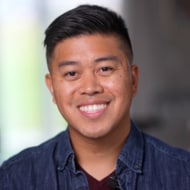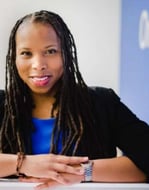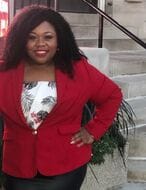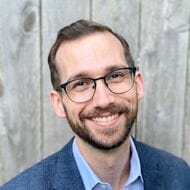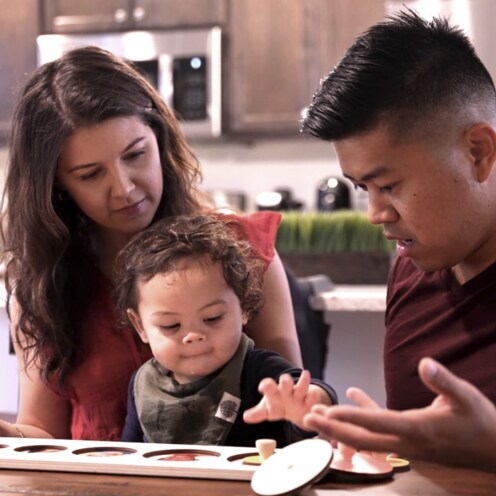
You Will Encounter the Model Minority Myth, but It Is Your Legacy to Resist It
In a letter to his son, educator and racial justice advocate Tony DelaRosa recounts his personal struggles with Asian stereotypes and the importance of building coalitions with other marginalized groups.
Dear Sebastian,
As we bring you in 100 percent Asian American, 100 percent Latinx, 100 percent Cuban, 100 percent Filipino, 100 percent brown, people will not always see your midi-chlorian count / people will force you into silence / and you must force yourself into sound / people will force you into bento boxes / and you must force them into the expansiveness of the kamayan / people will force you into their imaginations / of model minority / of being “minor” / but major solution-POC / into white-adjacencies / and you must force them into your lineage of resistance / of the Philippine anti-martial law movement / of Isang Bagsak / of ethnic studies / of Isang Bagsak / of abolitionist dreams / of Isang Bagsak / because radical futures will set us free...
I wrote this poem in May 2021 while you were in Momma's belly, ready to pop, with your little hand balled up in a fist. I like to think you were born out of love and rage. Our love for our people, our history, and our magic. Our shared rage for the type of world you are inheriting, an open wound of humanity.
By the time you read this, you will be at the intersection of pubescence, chaos, and the social event that is middle school. While you may not know all of the words and concepts I reference in this letter, I know you’ll understand the feelings. This letter is one of many I will write to you. See them as a North Star—especially when it gets dark.
This letter starts when I was in middle school. My family moved from Oceanside, California to Lebanon, Ohio. I had spikey Super Saiyan-like hair (that was a vibe at the time), lived under my sister's shadow, wore Converse, and sported clothes that never fit. (Nothing really quite fits in middle school.)
“Part of combating the myth is being in the trenches with other people of color.”
Around this time, I started experiencing the model minority myth, which is the concept of Asian American exceptionalism stemming from white supremacy and anti-Blackness. This concept makes many Asian Americans, and other marginalized communities, assimilate to the white dominant ideal of the American Dream.
Moving to Lebanon, I became a brown boy in a sea of white—imagine “Absolutely True Diary of a Part-Time Filipino.” Arnold, the main character of Sherman Alexie’s novel, left the reservation, but I left a Filipino and Mexican neighborhood to live in rural Ohio. The model minority myth slowly crystallized between seeing Asian Americans in the media outperforming other minority groups in school and the constant high expectations that my parents and our community had for people who looked like us.
I don’t blame my parents for passing down the conundrum of Filipino excellence and assimilation; I just wish they were able to delineate the two and provide much-needed context around the harm of this myth. I was not taught about the low rates of Southeast Asian Americans and Pacific Islanders who were able to earn high school diplomas. I was not taught about the disproportionate suicide rates among Asian American young adults.
There is so much that will not be taught to you, and so much you will have to unlearn.
Because of the model minority myth, we face internalized racial oppression and anti-Blackness. I avoided associating myself with other Black and brown kids because I thought associating myself with white students would increase my social status at the school—and it did. That is the danger of the myth—it’s successful in stripping you of any sense of shared identity between you and people of other marginalized communities. It rewards “excellence” through rigid individualism.
Another impact of the model minority myth is that it paints the visage that Asian Americans don’t face racism or discrimination. As a Filipino American, my first recollection of discrimination was at a Boys & Girls Club in Oceanside, California. I was playing foosball against a Black kid named Rashaun, and I beat him. After the winning shot, Rashaun called me a “stupid Puerto Rican ch*nk.” Later, Rashaun and his friends jumped me during recess.
These moments were visceral and traumatic, and they never left my body. Why was this the first thing to come out of Rashaun’s mouth? I eventually reported it and was gaslighted by the fact that no adult at the Boys & Girls Club acknowledged this or held any space for repair. Because of this, I had issues speaking up any time I faced any form of discrimination or racism. I pray that you can overcome the gaslighting you may experience and that you continue to seek justice and repair when you face these situations.
I also want you to know that this incident at the Boys & Girls Club may seem minor to others, but such hate speech is not new to the major tension that arises between the Black and Asian American communities. This tension dates back to 19th-century indentured servitude in America when white plantation owners would pick and choose between which racial group could more efficiently strengthen their farming enterprise. In Jonathan Tran’s recent book, “Asian Americans and the Spirit of Racial Capitalism,” he shares how Chinese indentured servants were often pitted against Black indentured servants in the late 1800s. Another example of Black and Asian American tension is the LA riots of 1992, precipitated by Los Angeles police beating Rodney King and the fatal shooting of Latasha Harlins by a Korean liquor store owner. Media coverage of those events exacerbated the racial tensions.
Get more articles like this delivered to your inbox.
The monthly ‘One Day Today’ newsletter features our top stories, delivered straight to your in-box.
Content is loading...
When I was in high school, the myth was particularly evident during talks about college readiness and tests. I scored low on every college readiness test, and a friend said I was a “failed Asian.” I remember the look of disbelief on his face after we exchanged scores. This stifling bento box of an imagination damaged my sense of self-worth and self-confidence.
After that incident, I lied about the scores I achieved on these tests because I wanted to maintain my academic facade and avoid being associated with not living up to the “standard.” I chose ego over humility. Egotism prevented me from rigorously engaging in my personal blind spots and interrogating the racist undertones of standardized testing. As Ibram X. Kendi said: "Standardized tests have become the most effective racist weapon ever devised to objectively degrade Black and brown minds and legally exclude their bodies from prestigious schools." With this knowledge, you’ll feel the tension when you see Asians and white people frequently coupled together as outperforming every other community. When you see this, I want you to remember to critically unpack what it means when any organization talks about Asians and success. Always ask, “Which Asians?” and remind yourself that we are not a monolith.
Fast forward to 2012, which was my first year of teaching. On the first day of school, one of the first things an elementary student said to me was, “Yes! We are going to be so good at math this year. We have a Chinese teacher.” I immediately felt my body tense up with conflicting emotions. I laughed as a defense mechanism. I sighed because I knew I was mediocre at math. (Sorry Sebastian, you will get your math magic from your mother.) A deeper sigh followed as I questioned the stories that my students were telling themselves about math, power, and access. Did they think Chinese people were the gatekeepers to math? Had they not met or seen other Asian Americans? Did no one help unlock their math magic up to this point in their pre-K through 12 experiences? Were they told the harmful stereotype that math was not for Black and Latinx children?
Interested in Joining Teach For America?
Sebastian, as a brown boy in a sea of white, like me, your ethnicity will be misidentified. In those moments, remember this line in my poem: “You are 100 percent Asian American, 100 percent Latinx, 100 percent Cuban, 100 percent Filipino.” Remember the pride and power associated with each identity.
When bias and bigotry arrive at your footsteps, those are moments when the myth functions to divide us, especially against other people of color. When my students called me Chinese, I could have lashed out and said, “That’s racist.” But that would have created more distance between us, which is the easy way out. Part of combating the myth is being in the trenches with other people of color—what some call cross-racial coalition building. It’s neither easy nor glamorous, and that’s why it’s difficult to find today. A foundation of cross-racial coalition building is recognizing that white supremacy is the water we drink, and therefore, we must discover and create our own wells. Cross-racial coalition building recognizes that we are all battling our own unique oppressions. Understanding a sense of shared struggle opens doors for empathy, power exchanges, and understanding of our collective power.
“I’m a realist, rooted in radical hope.”
I’m being one hundred when I say cross-racial coalition building will not be taught to you in school. So you will undoubtedly be over inundated with concepts like Isang Bagsak, Dalawang Bagsak, and Tatlong Bagsak by yours truly. These three Filipino phrases signify the past, present, and future of cross-racial solidarity. Isang Bagsak, Tagalog for “We fall and rise together,” forces us to remember and pay homage to cross-racial coalitions such as the 1960s Delano Grape Strike between the Filipino and Mexican American farmworkers who fought for labor rights, as well as the Third World Liberation Front movement in which San Francisco State University students from various multicultural student-led organizations banded together to create an ethnic studies program. Dalawang Bagsak reminds us to be present. It teaches us to FOIL: “First Observe If someone with Lived experience has shared,” a concept I learned from Joquina Reed. Tatlong Bagsak charges us to be visionaries, to continue cross-racial coalition building into the future, which brings me to you.
When you read this, the model minority myth will still exist like other forms of oppression. Sorry to be the bearer of bad news, but I’m a realist, rooted in radical hope.
I aspire for you to share this level of unconditional love toward social justice and its possibilities. It starts with remembering. Remember the fist you had in Momma's belly. Remember the many times I bombarded you with Isang Bagsak. Remember the other letters that I wrote to you that led to this one and, of course, more to come. The letters I write to you are like us: moments of change in the movement of mountains.
We want to hear your opinions! To submit an idea for an Opinion piece or offer feedback on this story, visit our Suggestion Box.
The opinions expressed in this piece, and all others in our Opinion section, represent those of the authors and do not necessarily reflect the views and opinions of the Teach For America organization.
Sign up to receive articles like this in your inbox!
Thanks for signing up!
Content is loading...


